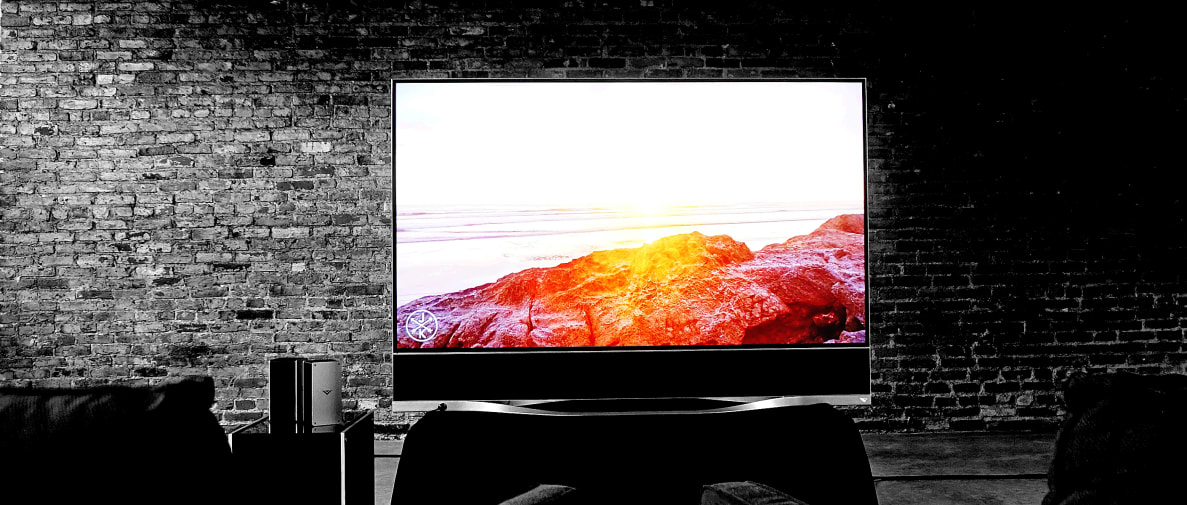Pros
-
Includes a surround-sound system
-
HDR and Dolby Vision support
-
Quantum-dot technology
Cons
-
Lackluster smart platform
-
Not the best at upscaling older (sub-HD) content
The TVs became available for special order shortly after, suggesting a masterfully timed release that would hit the market just in time to take advantage of the growing tide of new TV standards like HDR.. We've finally got the 65-inch Reference Series (Vizio RS65-B2, MSRP: $5,999) in our lab and have set Vizio's paragon to boil after two years of simmering. Does it really deserve the title of "Reference Series?" Well, you won't be disappointed. In fact, I'd bet this TV struts harder than any you've seen before.
Editor's note: We are currently scoring the Vizio Reference Series for standard performance only, not against benchmarks for either Dolby Vision or HDR10. In the future we may update the score to reflect the full extent of this TV's performance.
About the Vizio Reference Series
The Reference Series is available in only two sizes, and they're so different that this review only truly applies to the 65-inch version. The 120-inch Reference Series is so big it's basically a lifestyle choice.
• 65-inch (RS65-B2), MSRP: $5,999 • 120-inch (RS120-B3), MSRP: $129,999
Both Vizio Reference TVs are available for special order right now from Vizio's website, but we have seen reports of the 65-inch appearing at specialty retailers already. We spent about two weeks with the 65-inch Reference Series for testing and evaluation.
Despite the vast difference in price and size, the RS65 and RS120 are very similar in specs and features. Both feature 4K/UHD resolution, 10-bit color, native 120 Hz refresh rates, full-array local dimming (with the 65-inch delivering 384 "zones" of local dimming), and quantum dot color.{{amazon name="VIZIO E50-C1 50-Inch 1080p Smart LED TV (2015 Model)", asin="B00SMBFP4U", align="right"}}
More importantly, not only are both Reference Series TVs compatible with the new High Dynamic Range format, they're the first "Dolby Vision" approved sets on the US market, which means they need to be intensely bright and colorful compared to the average LED LCD television.
Here's the spec breakdown for the RS65-B2:
• 4K (3,840 x 2,160) resolution • 10-bit and Dolby Vision (Rec.2020 container) colorimetry/processing • Quantum dot color for wide color gamut/high dynamic range • Dolby Vision graded with 800 nit brightness • Full-array backlighting with 384 local dimming zones • Vizio Internet Apps Plus smart platform • Soundbar, subwoofer, and speakers included
Design & Accessories
{{ photo_gallery "design" }}
What We Like
Warning: We're about to go full nerd.
The Reference Series is basically a home theater in a box. The RS65-B2 (65-inch Vizio Reference Series) arrived in the second biggest TV box we've ever brought into our labs (first place goes to this 80-inch Sharp).
The box was easily seven feet long and almost two feet wide. This is because you can't actually buy just the 65-inch TV, but must purchase a whole "home theater in a box" that includes a subwoofer, tweeters, and a matching soundbar. Considering all of the TV's next-gen specs and compatibilities, the inclusion of all the audio equipment makes the price tag feel a little less crazy.
The Reference Series is built to last. Remember Panasonic's last couple years of plasma production? It was a special time for videophiles, not least of all because Panasonic's legendary plasmas were built like tanks—fitted with smooth, brushed metal that looked great and could take a beating.
The Reference Series is built to similar standards. It's hefty, weighty, sturdy, and is the most imposing and structurally sound Vizio TV I've ever seen. At least, it's a welcome departure from the cheaper materials worn by some Vizio TVs, even if it also fattens the price tag a bit.
The Reference Series is capable of unparalleled luminance—for now. The RS65-B2's intense luminosity is truly its selling point. As I write this, I'm sitting in our TV lab and the whole place is being lit up by the fanciest lamp of all time. I booted up Netflix to watch one of Louie Shwartzberg's Moving Art films in 4K—the one about Flowers—and was blown away by the TV's blinding brightness and color ability.
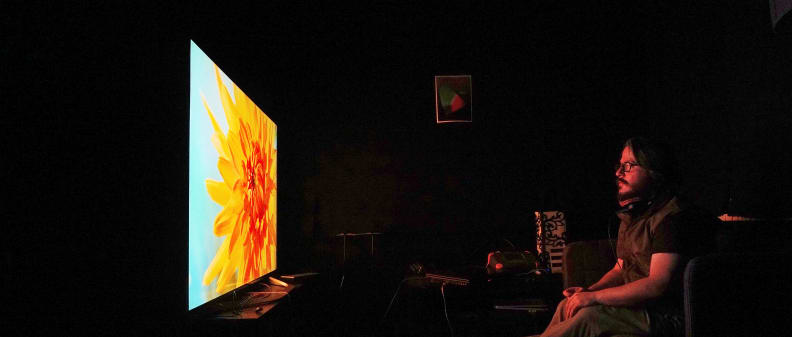

In the "subdued" Calibrated Dark picture mode (right), the TV is still brighter and more colorful than most LCDs from the past half-decade. In Vivid mode (left), it's so over the top your monitor can't even display the reds/oranges properly.
The RS65-B2 needs to be this bright because it's one of the first "Dolby Vision" graded sets on the market, and it's also eventually going to be HDR10 compatible (meaning it will play High Dynamic Range (HDR) content, but doesn't necessarily meet HDR standards). You don't need to watch DV/HDR content to enjoy this kind of "lumajesty," however.
How bright is this TV? Well, consider that SDR (standard dynamic range) LED TVs usually max out around 350 nits in their default retail/day mode, around 200 nits in their living room/night mode, and around 140 nits once I calibrate for home theater use. The Reference Series, on the other hand, excurses well above 700 nits.
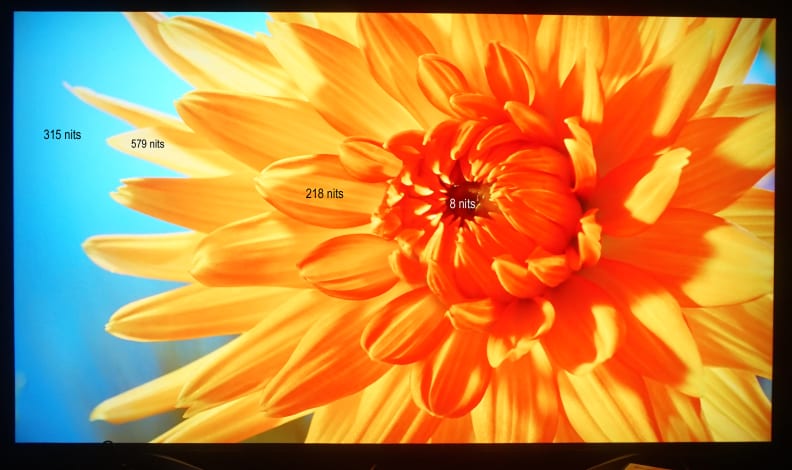
The RS65-B2's incredible brightness gives it the luminance muscle to make up huge differences between already bright, highlight areas.
During Moving Art: Flowers, I measured the luminance of a particularly bright scene involving a blooming yellow/orange/red colored flower. The middle, dark orange/red petal of the flower measured 218 nits, while the edge of its petals—more transluscent and thus allowing more sunshine to pass through—was a blazing bright 579 nits. The dark center of the flower measured 8 nits, which is a terrible black level—but is fine amongst such gigantic contrasting numbers.
The Reference Series delivers great black levels for such a bright TV. You'd think with how bright it gets the Reference Series might not produce the best black levels, but thanks to the full-array backlight with local dimming (sometimes abbreviated as "FALD") overall contrast is maybe the RS65-B2's greatest strength.
I measured the standard ANSI contrast pattern and found that (as you'd expect) the TV's overall contrast moves around a lot depending on which picture mode you use. The shadow level (or black level) is also heavily dependent on how many of the TV's 384 dimming zones can be shut off/suppressed in a single location.
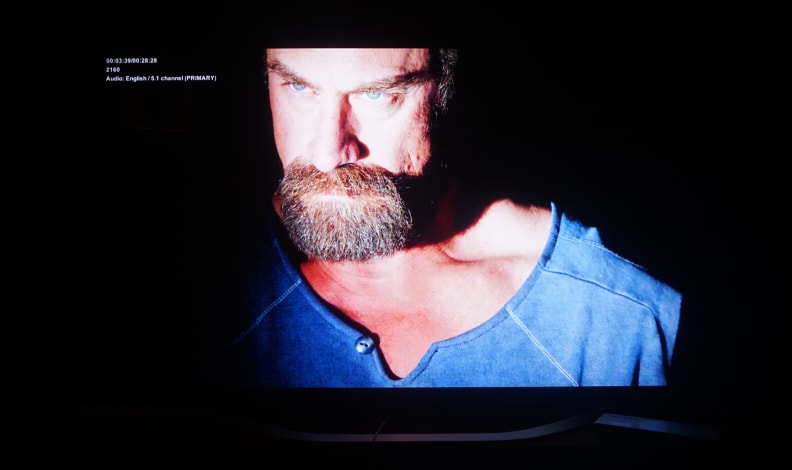
The RS65-B2 has 384 local dimming zones, making for incredible brightness that doesn't interfere with its ability to produce solid black levels (for an LED TV).
To that end, I measured black levels between 0.005 and 0.1 depending on backlight setting and picture mode, but the Calibrated mode (designed for "most" rooms) registered as probably the best default, boasting a ton of brightness without letting its shadows get too luminous. Overall, the TV averages about a 0.05, which is great for a non-OLED model.
Overall, you can expect shadow tones on the level with the average high-end LED TV—which is pretty awesome, considering how insanely bright this TV gets.
The Reference Series serves up oodles of beautiful color. The 65-inch Reference Series is equipped with a "quantum dot" enhanced panel, meaning it's capable of much higher color saturation than the average LED TV. This was easily apparent during viewing, especially in the super-bright "Vivid" mode.
Of course, Dolby Vision/HDR/4K content is still sparse, and it's very important that any TV you buy still handles standard content without clipping, crushing, or glossing over details. Fortunately, the Reference Series is equipped with the ability to actively detect the color/contrast definitions of incoming content and swap between standards as needed.
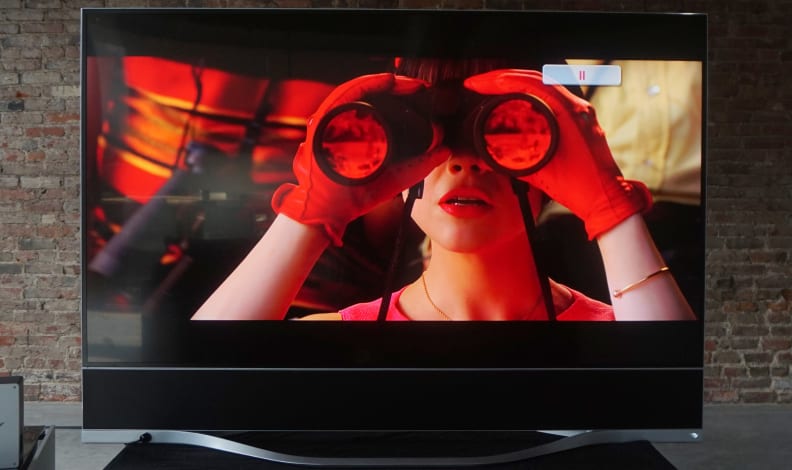
The Reference Series color saturation is literally off the (standard) charts. Reds in particular absolutely eclipse the performance of other TVs.
But really, if you're turning down the brightness to "standard" reference levels and reigning in the color to HD (rec.709/sRGB) gamut width, you're kind of doing yourself a disservice. Unlike most LED TVs from the last decade, the RS65's extra color doesn't come at cost to accuracy or picture details, as it possesses the necessary light output to maintain even emphasis.
We found that the most accurate mode for standard HD color is Calibrated Dark, while Calibrated adds a little extra color and Vivid really goes over the top.
The Reference Series passes most motion tests handily. One complaint we sometimes get about Vizio TVs are how they handle motion procession and resolution retention, especially with regards to 60fps content. Fortunately, the Reference Series is fitted with Vizio's best take on motion yet. It has multi-step De-Judder and De-Blur options, as well as "Clear Action," Vizio's method of backlight scanning.
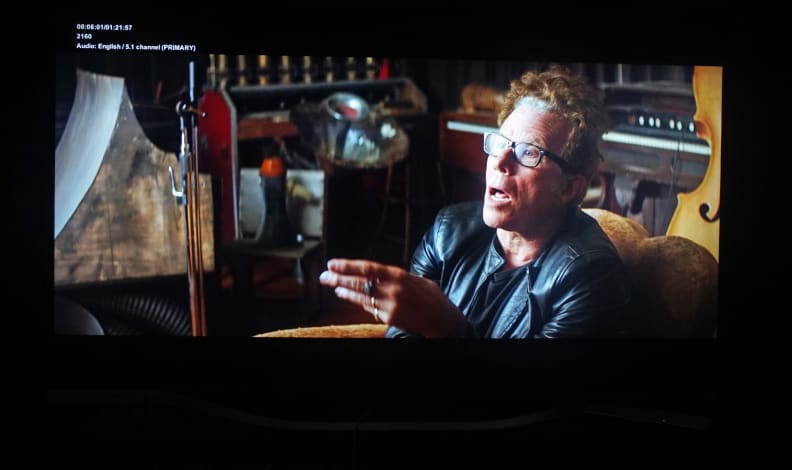
Though it tends to exhibit judder during panning without assistance, Vizio's De-Judder/De-Blur modes do wonders to aid with content rendering. The Clear Action backlight scanning mode is also extra useful since the TV's so bright.
While De-Blur interpolation can quickly introduce the "soap opera effect," I found that both the De-Judder or "Clear Action" modes did wonders to smooth out the more difficult 1080p at 24fps or 4K at 60fps content. In particular, I found Moving Art to be very juddery during horizontal panning and complex scenes, but a few clicks up on the De-Judder setting cleared it up wonderfully.
The motion isn't perfect, but if you're willing to tinker with the interpolation and telecine settings a bit you can find something you like.The Reference Series is also a decent choice for gaming, though with all of its extra abilities it exhibits slightly more input lag than other displays. I measured between 21 and 37 ms of input lag in "Game" mode, with much more (over 80 ms) in "Vivid" mode.
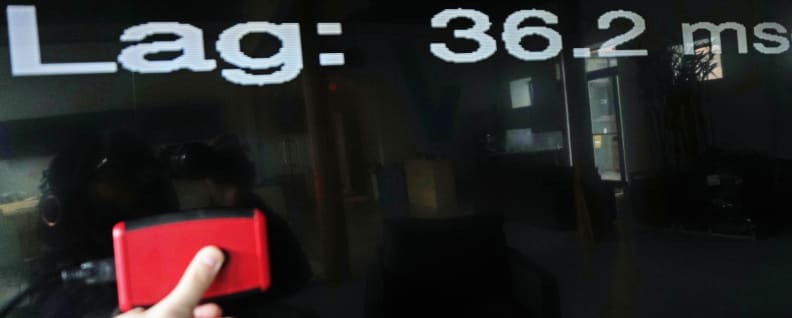
The Reference Series' 5th HDMI input, in Game mode, and with "Game Low Latency" enabled, offers up fairly minimal input lag.
The Reference Series does a good job suppressing blooming, trailing, and other issues. The RS65 has 384 local dimming zones. Compare that to 64 zones in the 2014 P Series and 240 zones in the highly respected 60-inch Sharp Elite from a few years ago. As with all full-array TVs, the more zones you have, the better the TV can control for bright and dark elements in one scene.
Fortunately, common FALD issues like blooming—an ugly side effect that happens when zones are too bright—or trailing—when zones are slow to dim/brighten—aren't much of a concern here. We designed a torture test for the RS65 consisting of randomly sized white squares to check out the bloom problem, and were pretty impressed at the Reference Series' ability to stem visible bloom.
{{ photo_gallery "FALD" }}
What We Don't Like
The Reference Series comes with so much extra junk. Yes, the included soundbar, tweeters, and subwoofer make the price a little easier to swallow, but I know for a fact there are interested shoppers out there who just want to buy the 65-inch Reference Series without all the extra audio equipment. Unless you're building a brand-new home theater, chances are most buyers willing to spend this much have their own sound systems already. The fact that the TV has no speakers of its own is testament to this idea, but you're still stuck with Vizio's included external audio solutions even if they're solutions to a problem you didn't have.
The Reference Series' menus and smart platform feel inadequate. Call it nitpicking, but I think a truly premium TV needs to have truly premium trimmings—even in the menu. And while the RS65 is built to last and boasts excellent picture quality, its menu interface looks jaggy and doesn't improve upon the "Vizio Internet Apps" platform in any way. It's basically identical to what you'll find on 2015's E or M Series TVs. Vizio may intend to update it at some point, but right now, it looks a little ugly.

The apps you'll find in the Reference Series' smart menu aren't high enough resolution, which makes them look noisy and bad.
The Reference Series is still ahead of its time. This TV has some serious chops: The extra color and ridiculous brightness are future-proof and powerful enough to make non-Dolby Vision/HDR content look worlds better. But it ultimately won't live up to its $6,000 price tag (for most people) until more content becomes available. This is no fault of the Reference Series, but right now it's kind of like a new video game console—only hardcore early adopters are going to want it since there just aren't many games yet.
The Reference Series doesn't do the greatest job of upscaling older content. The Reference Series looks great playing 1080p content off of Netflix or Blu-rays, but isn't the best choice if you watch a lot of cable/satellite content shot at 1080i, 720p, or lower resolutions. While the content certainly looks better for the RS65's color/brightness, and is rendered smoothly enough for sports, more detail-oriented fare like movies or nature documentaries are going to look a little stretched out if you're watching at less than 1080p. This is the case with most 4K TVs, however.
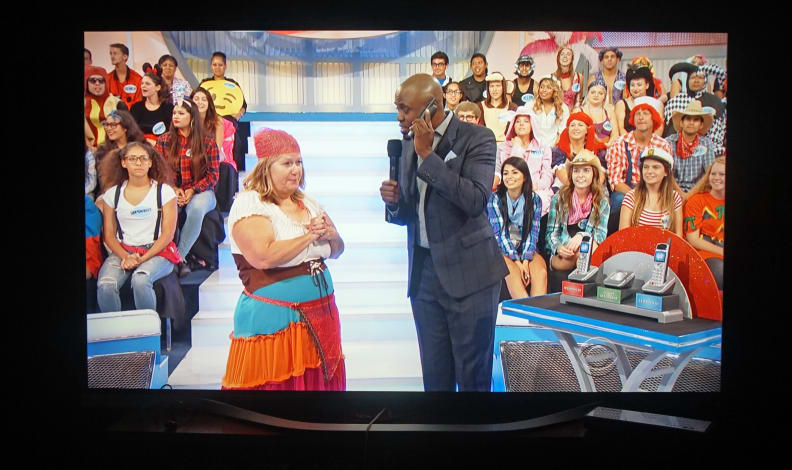
Though its brightness and color benefits anything you watch, older 720p, 480p, or 480i resolution content doesn't look terribly impressive on the Reference Series, as with most 4K TVs.
The Reference Series doesn't have a very wide viewing angle. For a TV billing itself as a reference screen—something other displays should aspire to look like—the RS65-B2 doesn't impress in terms of viewing angle. This TV uses a VA (Vertical Alignment) type LCD panel, which helps it produce deeper black levels for head-on viewing. But the alignment of the liquid crystal cells in the panel doesn't allow a ton of light to be communicated laterally, or out to the sides. This means you get a great picture during head-on viewing, but it quickly loses contrast as you move to the right or left.

The RS65-B2 doesn't have the best viewing angle, but it's right in line with expectations for VA panel LED LCD TVs.
This isn't really an issue with the Reference Series, but more an issue with VA in general. I measured a total viewing angle of 30°, or ±15° from the center to either side of the screen. This means if you're watching from 10 feet away, you can only move about three feet to the right or left of center screen before the picture starts to lose some contrast. While this is typical for VA-equipped LCD TVs, it's still a shame for a TV that's otherwise gorgeous.
The Reference Series doesn't have super accurate colors. The Reference Series produces tons of color, especially in Vivid mode or while playing Dolby Vision content. It's crazy impressive. Unfortunately, it doesn't do the best job of matching current color standards for most content. Perhaps because it can go so much further, the Reference Series struggles to reign in its extra color.
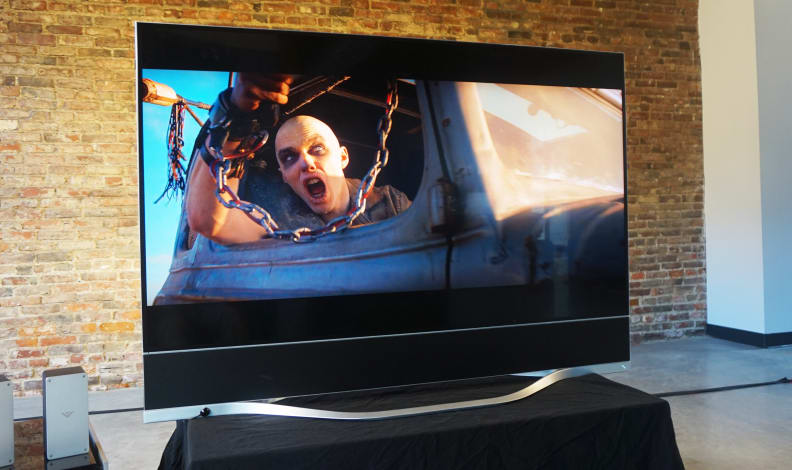
The RS65 produces a beautifully bright and saturated picture, but when playing standard content it isn't always the most accurate. This is something a calibrator could fix, however.
Even in the Calibrated Dark picture mode, it produces deeper red and green than it should. This isn't necessarily a bad thing—unless you're very picky about color accuracy—but it's still a disappointment considering 99% of content is still graded that way.
Should You Buy It?
Yes—if you have a home theater.
It's tempting to immediately champion Vizio's Reference Series as groundbreaking, but it's also the first of its kind. The first OLED TVs on the market blew minds too, but they needed improvements to get where they are today.
Don't get me wrong: I'd buy this TV in a heartbeat. It embodies a new kind of viewing experience, and makes me wonder why we've put up with "standard" dynamic range as long as we have. The blazing brightness, unyielding color, and brawny craftsmanship here is unlike anything I've seen before. It screams "witness me."
If you've got the money for it, the Reference Series will knock your socks off. Even without a bounty of Dolby Vision or HDR content, it looks great. Though a slew of similarly titanic TV's are on the way later this year from guys like Samsung, LG, Sony, and Panasonic, the Reference Series is the iceberg they're heading towards.
Other Options
The Reference Series is an excellent TV, but it isn't perfect. Here are some other options we think compare favorably. Just keep in mind that none of them include the wealth of external audio solutions that the Reference Series does, and they won't play Dolby Vision content either.{{amazon name="LG Electronics 65EF9500 65-Inch 4K Ultra HD Flat Smart OLED TV (2015 Model)", asin="B010RX0UKY", align="right"}}
If you've got a dedicated home theater with controlled lighting you might want to check out the LG EF9500 4K OLED. It's our #1 TV and about $1,000 less than the Reference Series. It doesn't get nearly as bright/colorful, but produces much better black levels. It's a better choice if you're not interested in Dolby Vision, but still want HDR.
If you're looking for a similar TV that doesn't cost as much you should check out the Samsung JS9500. This is Samsung's 4K, HDR-ready flagship from 2015. It's one of the best TVs the company has ever made, and right now you can find it online and at some retailers for less than $4,000. That's a steal. It's got full-array local dimming and quantum dot color, putting it in a similar ballpark as the Reference Series. Vizio's Reference Series is an extremely capable television, delivering more light output and sheer color ability than almost anything we've had in the lab. The only drawback is that it's a little ahead of its time.
It's too early to test it only for Dolby Vision compatibility or DCI-P3 color (the current/next steps in TV performance), so we ran mostly the same tests as we would on any other TV, including checking it for rec.709 (standard dynamic range/color) gamma, grayscale accuracy, and color production.
I tested the Calibrated Dark, Calibrated, and Vivid picture modes to get the best idea of how the RS65-B2 might look to most viewers. While we intend to eventually test for HDR/Dolby Vision, for the sake of timeliness and scoring parity we currently are only scoring the Reference Series against rec.709/standard performance margins.
Because it tested well out of the box, and uses a very specifically tuned gamma to compensate for FALD's effects on light output, I haven't yet calibrated the RS65-B2 to home theater standard performance.
Color Production
Calibrated Dark picture mode color gamut (uncalibrated)
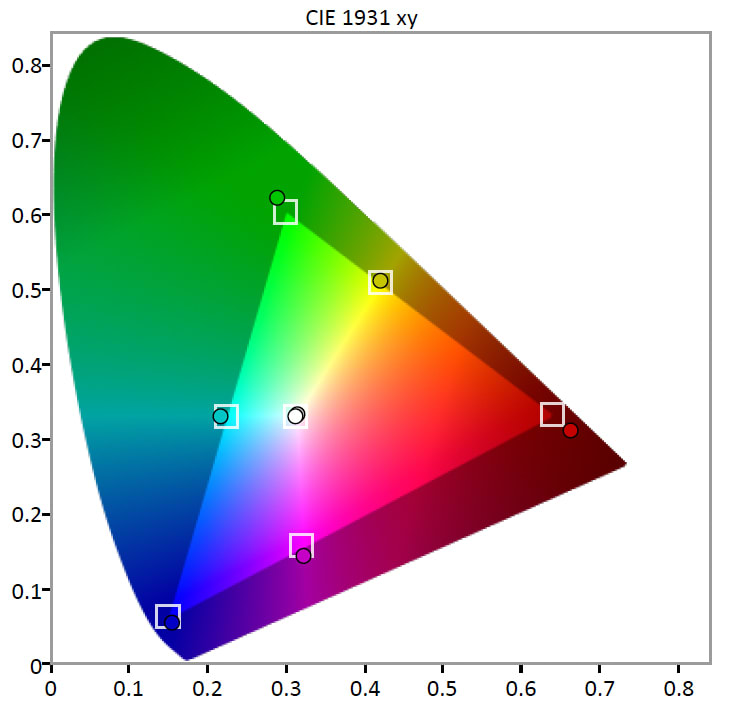
Even in the Calibrated Dark picture mode, the RS65-B2 produces slightly more red/green than is necessary for Rec.709/sRGB digital color production. This isn't necessarily a bad thing, but purists will want to hire a calibrator.
Vivid/Rec.2020 color (uncalibrated)
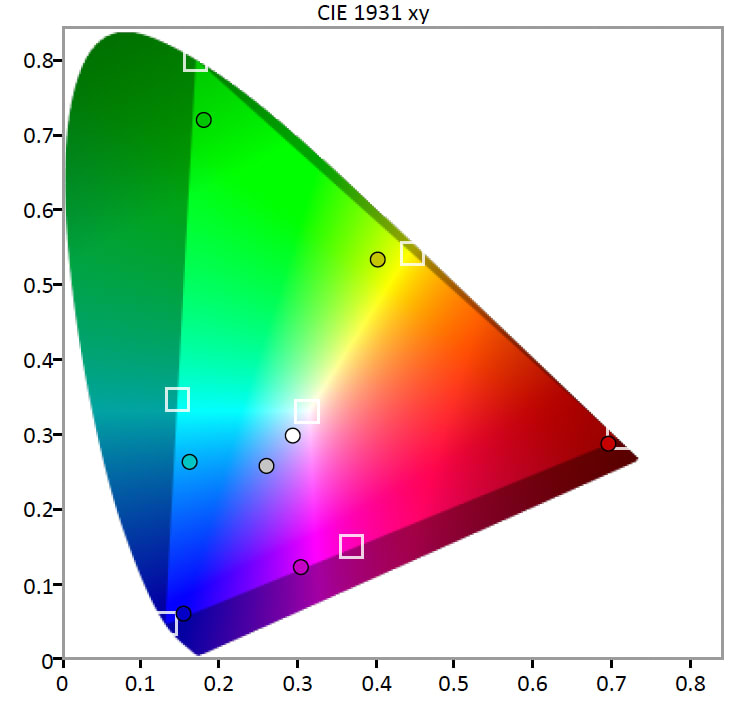
In Vivid mode, the TV produces an unprecedented amount of color. While Vivid mode doesn't produce the next-level UHD Rec.2020 color gamut with 100% accuracy, it creates as much or more color than any TV we've had in the lab.
RGB Balance & Grayscale
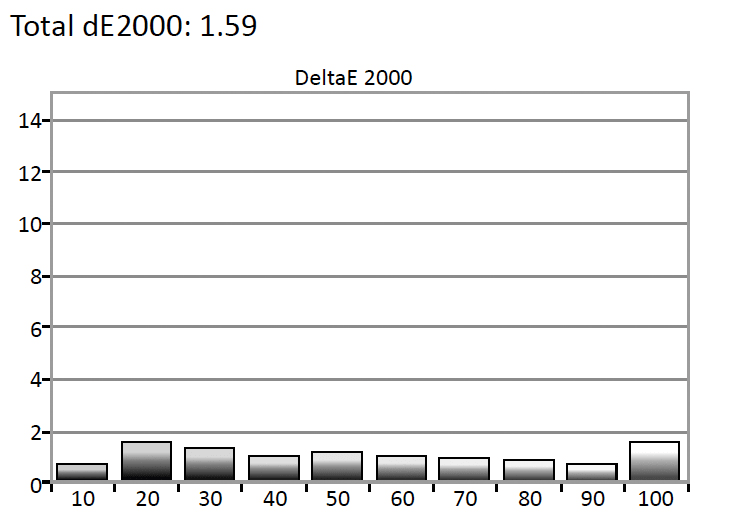
In the Calibrated Dark picture mode, the RS65-B2 tested with excellent grayscale tracking. DeltaE was less than 3 (meaning non-visible error) through the entire grayscale spectrum.
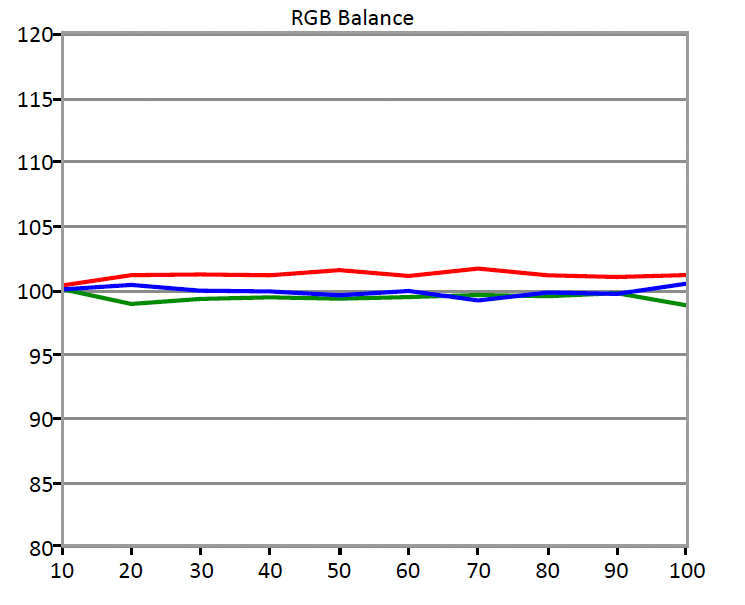
The RS65-B2's RGB balance results were very impressive. Even without calibration, the TV's grayscale tracking is nearly flawless.
Gamma
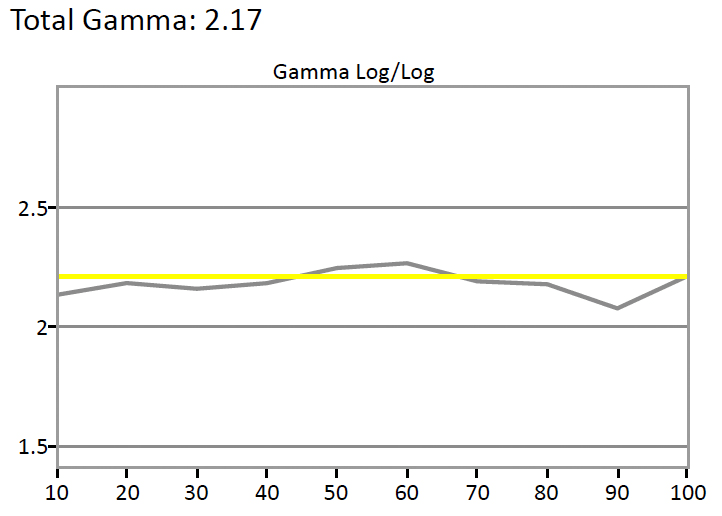
While not entirely flat, the RS65-B2's 2.17 gamma is quite close to the 2.2 standard for average room performance. This is a great out-of-box result, for sure.
Meet the tester
Lee was Reviewed's point person for most television and home theater products from 2012 until early 2022. Lee received Level II certification in TV calibration from the Imaging Science Foundation in 2013. As Editor of the Home Theater vertical, Lee oversaw reviews of TVs, monitors, soundbars, and Bluetooth speakers. He also reviewed headphones, and has a background in music performance.
Checking our work.
Our team is here to help you buy the best stuff and love what you own. Our writers, editors, and experts obsess over the products we cover to make sure you're confident and satisfied. Have a different opinion about something we recommend? Email us and we'll compare notes.
Shoot us an email
